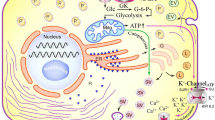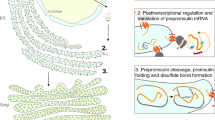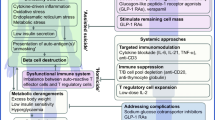Abstract
During the development of Type 1 diabetes, inflammatory cytokines are known to induce the expression of inducible nitric oxide synthase (iNOS) in pancreatic islets, and subsequent production of nitric oxide (NO) contributes to β cell destruction. Glucagon-like peptide-1 (GLP-1) has been shown to reduce cytokine-in-duced apoptosis of β cells. In this study, we investigated whether GLP-1 affects cytokine-in-duced NO production, resulting in the inhibition of β-cell apoptosis. We treated MIN6N8a mouse β cells with interferon (IFN)-γ in the presence or absence of GLP-1 and found that IFN-γ treatment induced iNOS mRNA expression and NO production, which was significantly inhibited by treatment with GLP-1. Blocking of GLP-1 receptor signaling via the cyclic AMP and phosphatidylinositol 3-kinase pathway did not directly affect the suppressive effect of GLP-1 on IFN-γ-induced iNOS mRNA expression. Further studies revealed that IFN-γ induced the expression of TNF-α mRNA and protein, which synergistically induced NO production, and GLP-1 treatment inhibited this induction of TNF-α. To examine whether the reduction of TNF-α by GLP-1 treatment plays a role in suppressing NO production, we treated MIN6N8a cells with IFN-γ in the presence of anti-TNF-α neutralizing antibody and found that NO production was reduced. In addition, treatment of mouse islets with GLP-1 inhibited the expression of iNOS and TNF-α mRNA. These results suggest that GLP-1 inhibits IFN-γ-induced NO production by suppression of TNF-α production.
Similar content being viewed by others
References
Reddy S, Yip S, Karanam M, Poole CA, Ross JM. An immunohistochemical study of macrophage influx and the co-localization of inducible nitric oxide synthase in the pancreas of non-obese diabetic (NOD) mice during disease acceleration with cyclophosphamide. Histochem J 1999, 31: 303–14.
Ventura-Oliveira D, Vilella CA, Zanin ME, Castro GM, Moreira Filho DC, Zollner RL. Kinetics of TNF-alpha and IFN-gamma mRNA expression in islets and spleen of NOD mice. Braz J Med Biol Res 2002, 35: 1347–55.
Rabinovitch A, Suarez-Pinzon WL, Sorensen O, Bleackley RC. Inducible nitric oxide synthase (iNOS) in pancreatic islets of nonobese diabetic mice: identification of iNOS-expressing cells and relationships to cytokines expressed in the islets. Endocrinology 1996, 137: 2093–9.
Darville Ml, Eizirik DL. Regulation by cytokines of the inducible nitric oxide synthase promoter in insulin-producing cells. Diabetologia 1998, 41: 1101–8.
Eizirik DL, Sandier S, Welsh N, et al. Cytokines suppress human islet function irrespective of their effects on nitric oxide generation. J Clin Invest 1994, 93: 1968–74.
Corbett JA, Lancaster JR Jr, Sweetland MA, McDaniel ML. lnterleukin-1 beta-induced formation of EPR-detectable iron-nitrosyl complexes in islets of Langerhans. Role of nitric oxide in interleukin-1 beta-induced inhibition of insulin secretion. J Biol Chem 1991, 266: 21351–4.
Karlsen AE, Pavlovic D, Nielsen K, et al. Interferon-gamma induces interleukin-1 converting enzyme expression in pancreatic islets by an interferon regulatory factor-1-dependent mechanism. J Clin Endocrinol Metab 2000, 85: 830–6.
Cetkovic-Cvrlje M, Eizirik DL. TNF-alpha and IFN-gamma potentiate the deleterious effects of IL-1 beta on mouse pancreatic islets mainly via generation of nitric oxide. Cytokine 1994, 6: 399–406.
Zumsteg U, Frigerio S, Holländer GA. Nitric oxide production and Fas surface expression mediate two independent pathways of cytokine-induced murine beta-cell damage. Diabetes 2000, 49: 39–47.
Yamada K, Otabe S, Inada C, Takane N, Nonaka K. Nitric oxide and nitric oxide synthase mRNA induction in mouse islet cells by interferon-gamma plus tumor necrosis factor-alpha. Biochem Biophys Res Commun 1993, 197: 22–7.
Liu D, Pavlovic D, Chen MC, Flodström M, Sandler S, Eizirik DL. Cytokines induce apoptosis in beta-cells isolated from mice lacking the inducible isoform of nitric oxide synthase (iNOS-/-). Diabetes 2000, 49: 1116–22.
Andersson AK, Flodström M, Sandler S. Cytokine-induced inhibition of insulin release from mouse pancreatic betacells deficient in inducible nitric oxide synthase. Biochem Biophys Res Commun 2001, 281: 396–403.
Flodström M, Tyrberg B, Eizirik DL, Sandler S. Reduced sensitivity of inducible nitric oxide synthase-deficient mice to multiple low-dose streptozotocin-induced diabetes. Diabetes 1999, 48: 706–13.
Takamura T, Kato I, Kimura N, et al. Transgenic mice over-expressing type 2 nitric-oxide synthase in pancreatic beta cells develop insulin-dependent diabetes without insulitis. J Biol Chem 1998, 273: 2493–6.
Drucker DJ. The biology of incretin hormones. Cell Metab 2006, 3: 153–65.
Li L, El-Kholy W, Rhodes CJ, Brubaker PL. Glucagon-like peptide-1 protects beta cells from cytokine-induced apoptosis and necrosis: role of protein kinase B. Diabetologia 2005, 48: 1339–49.
Hui H, Nourparvar A, Zhao X, Perfetti R. Glucagon-like peptide-1 inhibits apoptosis of insulin-secreting cells via a cyclic 5′-adenosine monophosphate-dependent protein kinase A- and a phosphatidylinositol 3-kinase-dependent pathway. Endocrinology 2003, 144: 1444–55.
Iwai T, Ito S, Tanimitsu K, Udagawa S, Oka J. Glucagon-like peptide-1 inhibits LPS-induced IL-1 beta production in cultured rat astrocytes. Neurosci Res 2006, 55: 352–60.
Li Y, Hansotia T, Yusta B, Ris F, Halban PA, Drucker DJ. Glucagon-like peptide-1 receptor signaling modulates beta cell apoptosis. J Biol Chem 2003, 278: 471–8.
Green LC, Wagner DA, Glogowski J, Skipper PL, Wishnok JS, Tannenbaum SR. Analysis of nitrate, nitrite, and [15N]nitrate in biological fluids. Anal Biochem 1982, 126: 131–8.
Jun HS, Yoon CS, Zbytnuik L, van Rooijen N, Yoon JW. The role of macrophages in T cell-mediated autoimmune diabetes in nonobese diabetic mice. J Exp Med 1999, 189: 347–58.
Yada T, Itoh K, Nakata M. Glucagon-like peptide-1-(7-36)amide and a rise in cyclic adenosine 3′,5′-monophosphate increase cytosolic free Ca2+ in rat pancreatic betacells by enhancing Ca2+ channel activity. Endocrinology 1993, 133: 1685–92.
Drucker DJ. Glucagon-like peptides: regulators of cell proliferation, differentiation, and apoptosis. Mol Endocrinol 2003, 17: 161–71.
Kim WH, Lee JW, Gao B, Jung MH. Synergistic activation of JNK/SAPK induced by TNF-alpha and IFN-gamma: apoptosis of pancreatic beta-cells via the p53 and ROS pathway. Cell Signal 2005, 17: 1516–32.
Suk K, Kim S, Kim YH, et al. IFN-gamma/TNF-alpha synergism as the final effector in autoimmune diabetes: a key role for STAT1/IFN regulatory factor-1 pathway in pancreatic beta cell death. J Immunol 2001, 166: 4481–9.
Chang I, Cho N, Kim S, et al. Role of calcium in pancreatic islet cell death by IFN-gamma/TNF-alpha. J Immunol 2004, 172: 7008–14.
Author information
Authors and Affiliations
Corresponding author
Additional information
These authors contributed equally
Rights and permissions
About this article
Cite this article
Hahm, E., Lee, Y.S. & Jun, H.S. Suppressive effects of glucagon-like peptide-1 on interferon-γ-induced nitric oxide production in insulinproducing cells is mediated by inhibition of tumor necrosis factor-α production. J Endocrinol Invest 31, 334–340 (2008). https://doi.org/10.1007/BF03346367
Accepted:
Published:
Issue Date:
DOI: https://doi.org/10.1007/BF03346367




